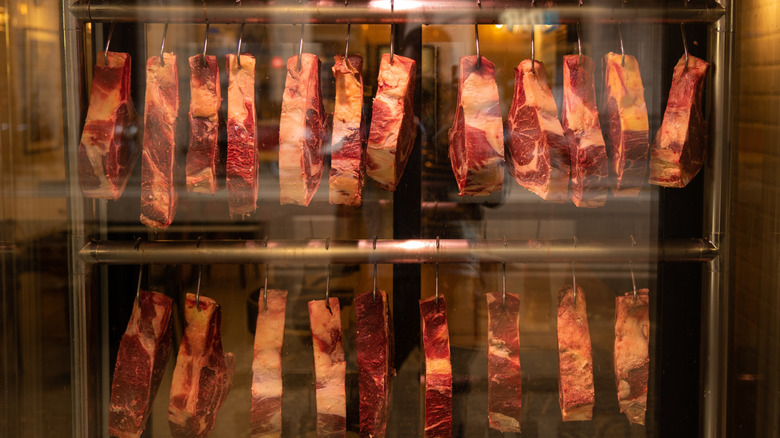Here's The Actual Difference Between Dry-Aging And Wet-Aging Beef
Beef lovers know that the texture and juiciness of aged beef are key to its overall appeal. But what many don't realize is that the flavor of beef is deeply influenced by the way it's aged. Wet-aging and dry-aging are two distinct methods used to enhance and preserve beef, each process offering its own impact on taste, texture, and aroma. Jon Urbana, founder of KOW Steaks, told Tasting Table that both processes create a more tender beef, but each method delivers differently when it comes to flavor. Ultimately, dry-aging produces the best results.
According to Urbana, traditionally, beef used to hang whole in chilled packing houses, aging naturally on the caucus before going on the market. "That time in the cooler was essential for developing flavor and tenderness," he explains. In contrast, wet-aging seals beef cuts in vacuum-sealed plastic immediately after processing, allowing them to age in their own juices. "It's a more modern method, but doesn't develop the same depth of flavor," Urbana says. For steak fans looking for something more robust, dry-aging involves aging specific individual cuts in a climate-controlled environment, which releases moisture and enhances flavor. Urbana adds that, "At KOW, we still believe in the traditional dry-aging process — it's how you get that rich, buttery texture and deep umami flavor."
How dry-aging and wet-aging impacts beef flavor
Time is not the only important factor in the beef dry-aging process. The methods involved also shape the beef's overall taste. But what exactly is different about the flavor in a dry-aged steak? "Dry-aging results in a more concentrated flavor — think nutty, earthy, and deeply savory," Urbana tells Tasting Table. "When done properly, it also improves tenderness by breaking down muscle fibers over time in a controlled way." Dry-aging is usually favored by chefs and steak connoisseurs because it produces a complex, flavor-rich steak.
According to Urbana, although wet-aging steak cuts might be more accessible and affordable, there is a downside to the vacuum-sealing method: "It maintains moisture but doesn't develop the same complexity or texture as dry-aged beef." Ultimately, the lack of bold, mature flavor in wet-aged beef makes choosing a steak much easier, so if you're ever unsure, chances are you won't be disappointed by selecting a dry-aged, more flavorful steak.
If you're feeling experimental in the kitchen, you could also try dry-aging your own steak, a labor-intensive process that's usually reserved for premium cuts of meat and serious flavor-seekers due to its tightly controlled conditions. As noted in a 2016 study in the Journal of Animal Science and Technology, the process is expensive because of the price of good-quality meat, "high aging shrinkage (6 to15 %)" and "risk of contamination." But with the right setup, a bit of patience, and determination, you can create restaurant-quality steaks at home.

